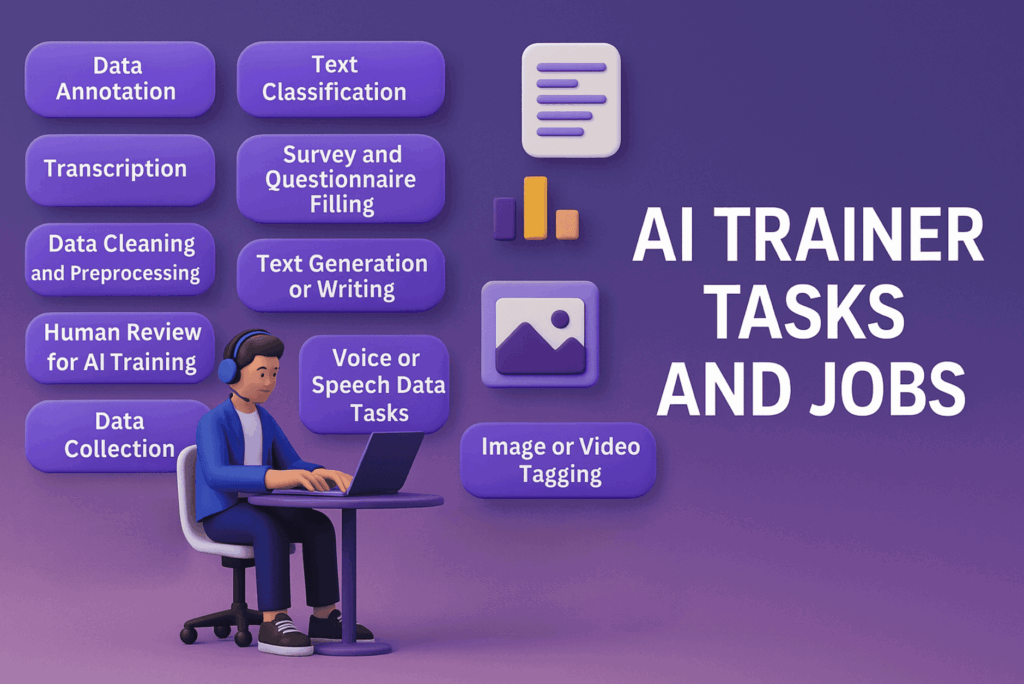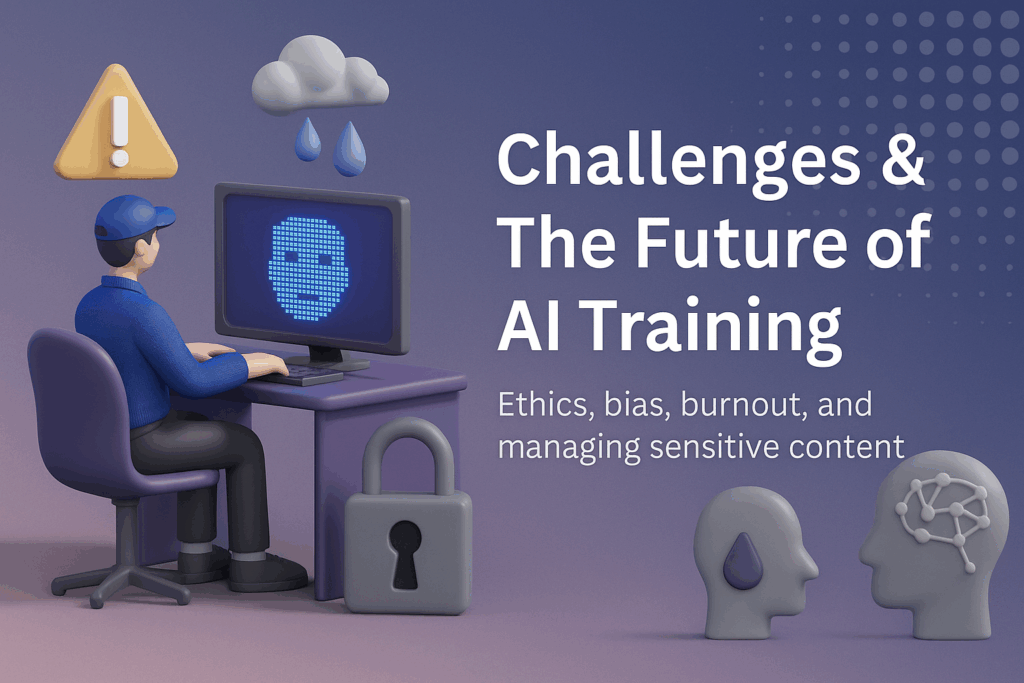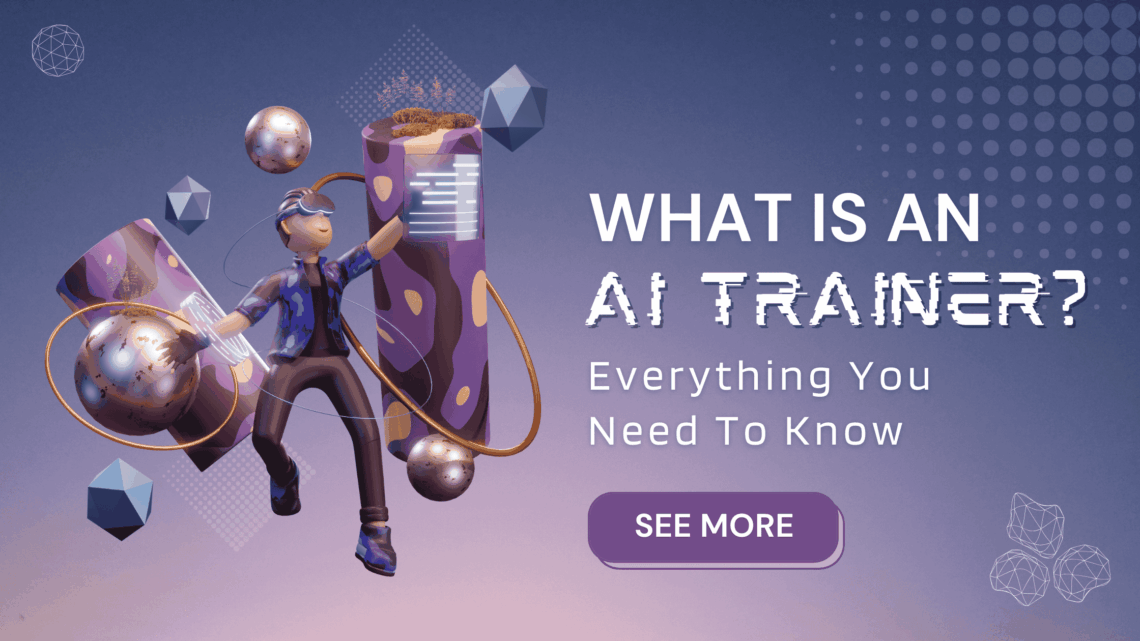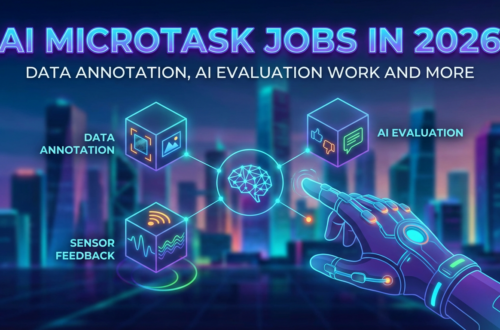Introduction
Artificial Intelligence (AI) powers everything from your smartphone assistant to your favourite streaming recommendations. Think of Siri predicting your next phrase, or ChatGPT crafting a witty reply. These “smart systems” don’t just emerge full-formed; they’re built, refined, and fine‑tuned by behind‑the‑scenes heroes known as AI Trainers. Without them, your AI wouldn’t know how to talk, listen, or serve.
So, who are these AI Trainers? If you’ve ever wondered how AI learns to be helpful, accurate, or creative, this blog dives deep into what an AI Trainer is, why they’re vital, and how you can become one. Whether you’re a freelancer, job seeker, entrepreneur, or tech newbie, buckle up, you’re about to meet the unsung architects of smarter systems.
What is an AI Trainer?
Definition in Layman’s Terms
An AI Trainer is like a coach for artificial intelligence. Just as a sports coach trains athletes with the right techniques, practice drills, and feedback, an AI Trainer teaches AI systems, such as language models and chatbots, how to understand, generate, and improve responses. They guide the AI through data, corrections, and real-world scenarios to make it “smarter” and more reliable.
The Rising Importance in the Era of LLMs and Generative AI
With the rise of Large Language Models (LLMs) like GPT, Claude, or Gemini, AI isn’t just a static system; it evolves. AI Trainers ensure these models grow in helpfulness, reduce mistakes, and respect context. As generative AI becomes more integrated into search, content creation, customer support, and more, the AI Trainer’s role continues to gain traction.
The Role of an AI Trainer in Building Smarter Systems

AI Trainers are the bridge between raw data and intelligent output. Their job isn’t just to teach AI; it’s to guide it toward human-aligned reasoning, ethical decision-making, and contextually aware responses. They play an instrumental role in turning static code into conversational companions and dynamic assistants.
Here’s a deeper look into their multifaceted contributions:
- Behavioral Refinement: AI Trainers analyze AI responses across thousands of examples – rating, ranking, and correcting them for tone, clarity, context, and helpfulness. This hands-on approach helps shape AI to mirror human expectations.
- Training Through Feedback Loops: Trainers are essential to the feedback loop system. They provide supervised feedback that the AI learns from, allowing it to improve future interactions. This iterative cycle is the heart of continual learning for generative models.
- Prompt Engineering & Scenario Design: AI Trainers develop effective prompts and test interactions to simulate how users engage with the AI. They evaluate edge cases, handle sensitive topics, and design real-world scenarios to prepare the AI for complex human queries.
- Bias Detection and Ethical Oversight: A critical part of the trainer’s role is identifying and reducing harmful or biased outputs. They help ensure AI respects ethical norms, cultural sensitivity, and legal compliance.
- Fine-Tuning for Specific Use Cases: From legal to healthcare domains, trainers adjust AI language and behavior to fit industry-specific regulations, terminology, and tone.
- Cross-functional Collaboration: Trainers work closely with machine learning engineers, product teams, designers, and data scientists. They align AI behavior with strategic product goals, usability, and user experience.
- Quality Assurance & Safety Checks: AI Trainers often serve as QA testers for conversational AI, flagging inappropriate or low-quality responses, rating multiple answer variations, and validating model consistency.
Real-World Examples:
- A customer service chatbot is trained to recognize distress signals and transfer the chat to a live support agent.
- A financial AI assistant is taught to avoid speculative advice and remain within compliance standards.
- An educational platform employs trainers to test whether its AI tutor can understand and adapt to a 12-year-old’s math mistakes.
In short, AI Trainers mould machines to think more like humans, without forgetting they’re machines. Their influence is felt in every polite response, context-aware suggestion, and emotionally intelligent reaction AI delivers.
Understanding AI Trainer Roles Across Industries
AI Trainers aren’t limited to tech companies; they’re rapidly becoming essential across industries. As more sectors adopt AI to streamline operations, improve user experiences, or personalize interactions, the demand for skilled AI Trainers is exploding. Here’s how different industries are embracing this role:
- Tech Startups & AI Labs: These are the testing grounds for cutting-edge AI applications. AI Trainers here often work on training large language models, testing generative tools, optimizing chatbot behavior, and refining search engine logic. They help startups iterate quickly and fine-tune outputs with minimal risk.
- Healthcare: In this high-stakes industry, AI Trainers help teach models how to communicate complex medical information clearly and compassionately. From assisting in patient chatbots to developing symptom-checking tools, trainers ensure AI remains compliant, non-diagnostic, and empathetic.
- EdTech: Education technology companies rely on AI Trainers to shape interactive learning tools. These trainers help develop AI tutors that respond appropriately to student questions, adapt content difficulty based on performance, and offer meaningful feedback that encourages learning.
- E-commerce: AI Trainers help develop smart recommendation engines, personalized search functions, and AI-driven customer service bots. Whether it’s helping a chatbot understand return policies or suggesting the right product based on vague user input, trainers are vital.
- Finance: With regulatory sensitivity and jargon-heavy content, AI Trainers in finance ensure AI advisors and bots provide compliant, responsible, and understandable assistance.
- Legal Services: Trainers help fine-tune AI systems that support legal research, document summarization, or client communication tools. Precision and neutrality are critical here.
- Media & Content: AI Trainers work with generative content tools training models that write, summarize, or curate content. They help the AI understand tone, format, audience, and fact-checking expectations.
Use Cases:
- A freelance AI Trainer is hired by a healthtech startup to fine-tune an AI assistant that explains diagnoses in simple language, ensuring compliance with HIPAA guidelines.
- An edtech company contracts trainers to teach its AI how to support students preparing for competitive exams, adapting content difficulty to individual learning curves.
- An e-commerce brand brings in freelance trainers to help its product recommendation engine understand seasonal demand and user preferences in different regions.
Why This Matters:
As industries race to implement AI, domain-specific knowledge becomes gold. AI Trainers bring human context, empathy, and cultural understanding that generic models lack. This is why freelancers with industry expertise, whether in education, healthcare, or finance, can provide immense value and command higher rates.
Good News for Freelancers: These roles are often remote, project-based, and scalable, making them ideal for freelancers on platforms like Truelancer. Whether you’re an industry veteran or a skilled communicator with a passion for AI, your knowledge can shape the future of intelligent systems.
Common AI Trainer Tasks and Jobs

AI Trainers perform a diverse range of tasks that span across technical, creative, and quality assurance domains. These roles are not only foundational to training AI models but also highly accessible to individuals with different educational and professional backgrounds. Here’s a detailed look at the most common and impactful AI Trainer tasks:
- Data Annotation: This is the bread-and-butter of AI training. Trainers label data, text, images, audio, or video so that the AI can recognize patterns. For example, labeling emotions in customer support messages or identifying objects in photos.
- Transcription: Turning audio or video speech into accurate text. This helps train voice assistants, automated subtitles, and language processing models.
- Text Classification: Categorizing written content by intent, sentiment, or subject matter. For instance, identifying whether a user’s query is a complaint, a suggestion, or a general inquiry.
- Data Cleaning and Preprocessing: Raw data is messy. Trainers help remove irrelevant content, fix errors, and standardize formats so that AI models learn from clean, high-quality inputs.
- Survey and Questionnaire Filling: Completing structured forms to provide subjective feedback or simulate user behaviors. These insights are valuable for evaluating how AI models perform in real-life scenarios.
- Human Review for AI Training: Trainers are often asked to assess AI outputs, flag problems, and offer corrections. This ensures the AI’s learning remains aligned with human expectations.
- Text Generation or Writing: Creating sample dialogues, narratives, or factual summaries that the AI can learn from. This task is especially useful for training generative models in specific tones or formats.
- Data Collection: Gathering new, relevant content to train AI systems. This can include recording voice samples, curating text datasets, or capturing real-world interactions.
- Voice and Speech Data Tasks: Involves speaking specific phrases or reviewing pronunciation to help train speech recognition models. Diversity in voice samples helps improve model inclusivity.
- Image or Video Tagging: Assigning descriptive tags to visuals so AI can learn to identify actions, objects, or scenes. It’s a key part of training computer vision systems.
- Human-Powered AI Training: Involves tasks like ranking AI-generated responses, comparing multiple outputs, and selecting the most human-like or accurate one. This helps refine large language models (LLMs).
- Content Moderation: Screening content for offensive, biased, or inappropriate language. Trainers act as gatekeepers to ensure AI-generated content remains respectful, fair, and safe.
Why This Matters:
These tasks don’t require deep programming knowledge. If you’re detail-oriented, analytical, or creative, there’s a role for you in AI training. Many of these tasks are modular, making them perfect for part-time, freelance, or remote work.
Empowering New Talent: This space opens the door for teachers, writers, linguists, students, and professionals from non-tech backgrounds to get involved in the AI ecosystem. All you need is curiosity, a willingness to learn, and a drive to contribute.
Freelance platforms like Truelancer offer abundant opportunities in these areas. You can start with small projects, build your portfolio, and grow into higher-paying specialized roles over time.
Bottom Line: AI Trainer tasks are the building blocks of intelligent systems, and your skills could be the missing piece.
How to Become an AI Trainer: Skills, Tools & Certifications
Breaking into the world of AI training doesn’t require a Ph.D. in machine learning. What it takes is a combination of human-centric thinking, curiosity, and the willingness to learn both technical and soft skills that align with how AI systems are taught and evaluated. Here’s how you can start your journey:
1. Educational Background (Optional but helpful)
While formal education can provide a strong foundation, it’s not a requirement. Many successful AI Trainers come from diverse academic paths:
- Computer Science, Linguistics, Psychology, Communication, or Journalism.
- Humanities majors with strong critical thinking and analytical skills can thrive, especially in tasks involving language, ethics, or user behavior.
2. Develop Soft Skills First
AI is trained by people who understand people. That’s why soft skills are essential:
- Communication: Clearly articulating feedback and understanding user expectations.
- Critical Thinking: Spotting inconsistencies, biases, and opportunities for improvement.
- Empathy & Cultural Awareness: Ensuring AI responses are respectful, inclusive, and relevant across demographics.
- Attention to Detail: Detecting subtle errors in tone, grammar, logic, or context.
3. Build Technical Proficiency
You don’t need to become a coder overnight, but technical fluency gives you an edge:
- Data Annotation Tools: Learn platforms like Labelbox, SuperAnnotate, and Scale AI.
- Prompt Engineering: Experiment with OpenAI’s Playground, Claude, or Gemini to test prompts and analyze outputs.
- Basic Python & APIs: Understanding Python basics and how to use APIs can help automate tasks and interact directly with models.
- Data Handling: Learn how to clean, sort, and manage datasets effectively using spreadsheets, JSON, or CSV files.
4. Take Certifications & Courses
Certifications signal your readiness to employers and clients. Popular options include:
- Coursera: DeepLearning AI’s Prompt Engineering for ChatGPT, AI For Everyone, or NLP Specialization.
- Udemy: Courses in AI ethics, machine learning basics, and prompt writing.
- LinkedIn Learning: Quick tutorials on annotation, LLM interaction, and AI business use cases.
5. Practice Through Real-World Projects
Hands-on experience matters. Start small:
- Join AI research or annotation competitions on Kaggle or Zindi.
- Volunteer on open-source AI projects or contribute to GitHub repositories.
- Try personal projects like building a basic chatbot, refining prompts, or creating your own dataset.
6. Build a Portfolio & Freelance Profile
Showcase your work and learning journey:
- Create a simple website or portfolio on Notion or GitHub.
- List projects, certifications, and testimonials.
- Use Truelancer to create a compelling profile that emphasizes your understanding of AI model behavior, language skills, or domain expertise.
7. Stay Updated with AI Trends
AI is constantly evolving, and so should you:
- Follow AI influencers on LinkedIn and Twitter.
- Subscribe to newsletters like Import AI, The Batch, or MIT Technology Review.
- Explore research papers on platforms like arXiv to understand where the industry is heading.
Final Thought: Becoming an AI Trainer is one of the most accessible and rewarding ways to enter the AI industry. It bridges people and machines, logic and empathy, structure and creativity. Whether you’re a freelancer, a curious learner, or a domain expert, there’s a place for you in this space.
Challenges & The Future of AI Training

As AI technology scales across industries, the role of AI Trainers is evolving, bringing both opportunities and challenges. To stay ahead, it’s important to understand the shifting landscape, emerging complexities, and where this career is headed.
Key Challenges in AI Training
1. Rapid Technological Change LLMs and generative AI are evolving at lightning speed. New models, frameworks, and architectures are released regularly, which means AI Trainers must keep pace with constant updates in tools, APIs, prompt behavior, and ethical guidelines.
2. Ambiguity in Outputs AI models are not always predictable. Even with clear inputs, outputs can vary in tone, accuracy, or coherence. Trainers often face the challenge of standardizing responses and teaching AI to behave consistently across edge cases.
3. Balancing Creativity and Compliance In industries like healthcare, finance, and legal tech, creativity in AI responses must be weighed against compliance and regulation. AI Trainers walk a fine line between expressive, human-like replies and industry-safe language.
4. Emotional and Cognitive Load Reviewing AI outputs, especially sensitive or offensive content, can be mentally taxing. Trainers need to maintain emotional resilience and apply fair, unbiased feedback while managing large volumes of data.
5. Limited Standardization The AI training industry is still relatively new. There are few global standards for how prompts are structured, outputs are evaluated, or performance is measured. This lack of consistency creates a fragmented training experience across organizations.
6. Risk of Automation Ironically, parts of the AI training process itself are being automated through synthetic data and self-supervised learning. While this increases efficiency, it raises questions about the long-term role of human trainers, and emphasizes the need to specialize in tasks where human judgment remains irreplaceable.
The Future of AI Training
Despite the challenges, the future for AI Trainers is incredibly promising. Here’s why:
1. Rise of Human-in-the-Loop Systems AI won’t replace humans; it will augment them. AI Trainers will play a key role in feedback loops where human evaluation is used to refine AI behaviour. As automation expands, so does the need for human oversight.
2. Multilingual & Multicultural Training As AI expands globally, demand is rising for trainers who can localize models across languages, dialects, and cultural contexts. Multilingual trainers with regional expertise will be in high demand.
3. Ethical AI as a Priority With rising awareness around algorithmic bias and responsible AI use, trainers who understand ethics, fairness, and transparency will become invaluable. Companies are already building “AI Ethics Boards” that include experienced trainers.
4. Expansion of Domain-Specific AI AI is moving beyond general-purpose chatbots into specialized verticals, legal AI, mental health bots, AI therapists, and financial advisors. Each domain needs trainers with subject-matter expertise who can shape appropriate responses.
5. Freelancing & Remote-First Growth As more companies adopt distributed AI development teams, freelance AI Trainers will enjoy increased flexibility and demand. Platforms like Truelancer make it easier than ever to find projects, upskill, and earn income on your own terms.
Skills That Will Future-Proof You as an AI Trainer
- Data validation and annotation strategy
- Domain expertise (health, law, education, finance)
- Advanced prompt engineering
- Ethical evaluation and fairness auditing
- Multilingual communication
FAQs: Frequently Asked Questions About AI Trainers
Q1: Is being an AI Trainer a technical job? A: Not necessarily. While having technical skills like basic Python or familiarity with APIs can help, many AI Trainer roles focus on language, behavior analysis, content moderation, and prompt writing—areas where soft skills and domain expertise matter more than coding ability. The role is ideal for professionals from linguistics, communication, education, psychology, and even humanities backgrounds.
Q2: Can I become an AI Trainer without a tech degree? A: Absolutely. Many AI Trainers come from non-tech backgrounds. What matters most is your ability to analyze, think critically, communicate effectively, and provide human insight that machines can’t replicate. Certifications and hands-on experience matter more than formal education.
Q3: How much can I earn as an AI Trainer? A: Salaries vary based on region, experience, and job type. Freelancers typically earn between $20 to $100+ per hour. Full-time roles in the U.S. and Europe often pay between $80K to $150K annually. Specialized roles or trainers with domain expertise can command even higher rates.
Q4: What does a typical day look like for an AI Trainer? A: It depends on the project. Tasks may include reviewing AI outputs, annotating data, crafting and testing prompts, ranking responses, or collaborating with data scientists to refine model performance. Most trainers work remotely, managing tasks through collaborative platforms.
Q5: Can I work as a freelance AI Trainer? A: Yes! Freelancing is one of the most common ways to break into AI training. Platforms like Truelancer connect skilled professionals with AI startups and research labs seeking on-demand support. Freelancing offers flexibility, remote work, and opportunities to explore different industries.
Q6: What tools should I learn to become an effective AI Trainer? A: Get familiar with tools like OpenAI Playground, Labelbox, Scale AI, Notion, Slack, and basic spreadsheet software. Also, explore platforms like Hugging Face for understanding model behavior and prompt responses.
Q7: How do I stand out as a freelance AI Trainer? A: Build a strong profile with clear examples of your work, certifications, and specialties. Demonstrate your ability to evaluate AI behavior, communicate feedback, and understand both the human and machine side of training. Portfolios and client testimonials add credibility.
Q8: Is this a long-term career or just a trend? A: It’s here to stay. As AI systems expand into more sectors, the demand for human-in-the-loop oversight is increasing. Ethical AI, personalization, and user-aligned systems will always require human trainers to maintain relevance and trust.
Q9: Where can I find AI Trainer jobs? A: Start with freelance platforms like Truelancer, Upwork, or Toptal. Explore job boards like AIJobs, LinkedIn, and AngelList. Many AI companies also hire part-time or contract-based trainers for specific model improvement projects.
Conclusion: The Human Side of Smarter AI
As we move deeper into the age of artificial intelligence, the need for human influence becomes not only important but essential. AI Trainers are not just facilitators of machine learning; they are translators of human experience, guardians of ethics, and architects of empathy in digital systems.
The role blends the analytical with the intuitive. It’s where logic meets language, data meets diversity, and algorithms are balanced with emotional intelligence. Whether you’re correcting a chatbot’s tone, teaching a language model to recognize humor, or ensuring an AI assistant respects cultural nuance, your input matters.
AI Trainers are paving the way for more human-aligned, safer, and smarter AI systems. This is a profession where your unique background, your worldview, your voice can directly shape how billions of people interact with technology every day.
And the best part? You don’t need to be a machine learning expert to start. You just need a desire to learn, a sharp eye for language and logic, and a passion for impact.
Whether you’re a freelancer, a career switcher, or a curious learner, now is the perfect time to enter this field and grow with it.
Ready to start your journey as an AI Trainer?
➡️ Sign up on Truelancer to explore freelance AI Trainer jobs, collaborate with leading AI companies, and be part of a movement that shapes the future of human-AI collaboration.
Your skills can teach AI to think better. Your insight can make AI safer. Start your AI Trainer journey on Truelancer today.






